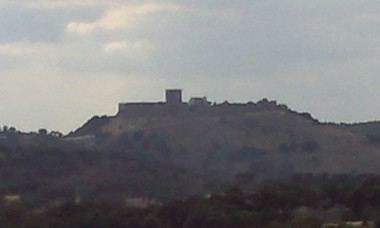Coordinates 38.177767, -7.062717 | Phone +351 285 950 630 | |
 | ||
Address Noudar, 7230 Barrancos, Portugal Similar Castle of Serpa, Castelo de Mértola, Alqueva Dam, Castle of Beja, Castle of Belver | ||
The Castle of Noudar (Portuguese: Castelo de Noudar) is a medieval castle the county of Barrancos of the Portuguese district of Beja.
Contents
Early History
Archaerological evidence suggest early occupation extend back to prehistory. Evidence also suggests that the region was occupied by the Romans, Visigoths and Muslims. The Moors were responsible for the primitive fortification in place around the 10th and 11th century.
Medieval era
During the Christian reconquest of the Iberian Peninsula, the area was taken and added to Portuguese territory. In 1253, the land was integrated by King Alfonso X of Castile in a dowry with his daughter Brities.
Control over the village was permanently transferred to the Portuguese Crown by the 1295 Treaty of Guard, which established peace between King Denis (1279-1325) and Ferdinand IV of Castile. Later that year in December, King Dinis of at same year, the sovereign has new charter Foral the village.
Post-middle ages
At the time of King Manuel I (1495-1521), the castle and its architecture are recorded by Duarte de Armas in his Book of Fortress (c. 1509). The village have received a new Foral charter in 1513.
The village and its ancient castle were occupied by Spanish troops during the Portuguese war for independence in 1644 until the War of Succession of Spain in 1707.
The Noudar Castle and its district returned to Portuguese control by Article V of the second Treaty of Utrecht on February 6, 1715.
Modern era
The village of Noudar, starting 1825, slowly decreased in population. The castle lost its importance in the 17th century. Due to the population decreased, the maintenance of the castle was neglected. The castle slowly degraded into ruin due to the natural elements.
On June 23, 1910, the IGESPAR arm of the Portuguese government classified as a National Monument.
IGESPAR intervened in the 1980s and carried out the reconstruction of the church and the Keep.
Architecture
The castle features a hexagonal plant with a northwest-southeast longitudinal axis, which defines two spaces: the citadel and the fence of the village. The citadel is dominated by the main tower of quadrangular plant, which stands at 18 meters high. The tower is crowned with battlements that defends the enclosure entry. It has two doors to separate floors and inside on the second floor accessible via a stone staircase opens up a cistern. According to the iconography of Duarte de Armas (c. 1509), its interior was vaulted and provided more superior room. Still in the Alcazaba, next to the donjon, a second tank it has arches supporting the dome. The walled fence and the keepis reinforced by a dozen towers and turrets addorsed, the main of which protecting the Port Vila. Inside stand out the Church of Our Lady of Exile, rebuilt in the 1980s.
Legend of the Moorish snake
According to local legend, the sole inhabitant is a magical snake. The serpent is believed to be an enchanted Moorish princess who only comes out at night, moving around on the castle grounds. It is said that the snake possesses the head of a old lady with the characteristic hair style of the braided head of old ladies.
